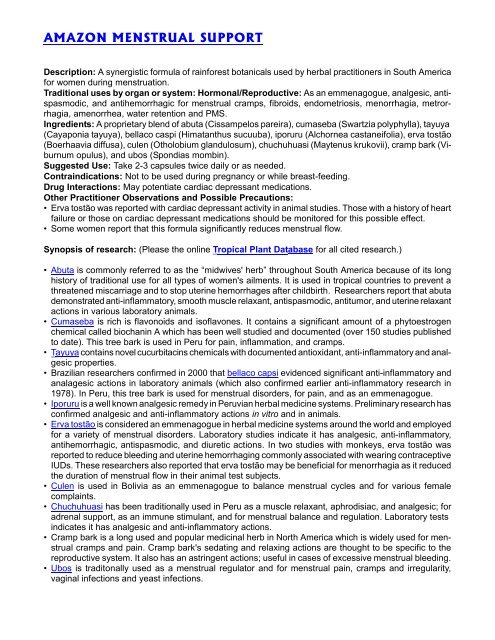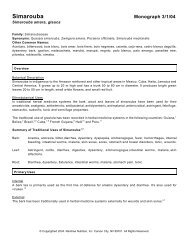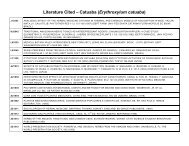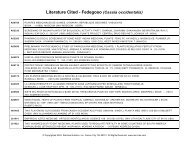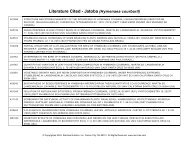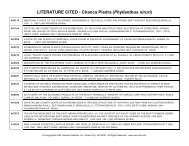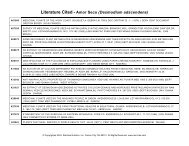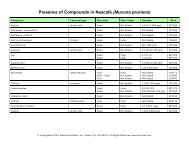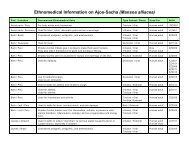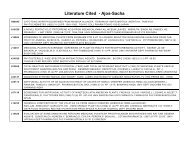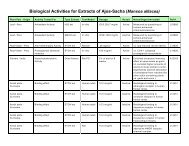Organ Specific Guide - Raintree Nutrition, Inc
Organ Specific Guide - Raintree Nutrition, Inc
Organ Specific Guide - Raintree Nutrition, Inc
Create successful ePaper yourself
Turn your PDF publications into a flip-book with our unique Google optimized e-Paper software.
AMAZON MENSTRUAL SUPPORT<br />
Description: A synergistic formula of rainforest botanicals used by herbal practitioners in South America<br />
for women during menstruation.<br />
Traditional uses by organ or system: Hormonal/Reproductive: As an emmenagogue, analgesic, antispasmodic,<br />
and antihemorrhagic for menstrual cramps, fibroids, endometriosis, menorrhagia, metrorrhagia,<br />
amenorrhea, water retention and PMS.<br />
Ingredients: A proprietary blend of abuta (Cissampelos pareira), cumaseba (Swartzia polyphylla), tayuya<br />
(Cayaponia tayuya), bellaco caspi (Himatanthus sucuuba), iporuru (Alchornea castaneifolia), erva tostão<br />
(Boerhaavia diffusa), culen (Otholobium glandulosum), chuchuhuasi (Maytenus krukovii), cramp bark (Viburnum<br />
opulus), and ubos (Spondias mombin).<br />
Suggested Use: Take 2-3 capsules twice daily or as needed.<br />
Contraindications: Not to be used during pregnancy or while breast-feeding.<br />
Drug Interactions: May potentiate cardiac depressant medications.<br />
Other Practitioner Observations and Possible Precautions:<br />
• Erva tostão was reported with cardiac depressant activity in animal studies. Those with a history of heart<br />
failure or those on cardiac depressant medications should be monitored for this possible effect.<br />
• Some women report that this formula significantly reduces menstrual flow.<br />
Synopsis of research: (Please the online Tropical Plant Database for all cited research.)<br />
• Abuta is commonly referred to as the “midwives' herb” throughout South America because of its long<br />
history of traditional use for all types of women's ailments. It is used in tropical countries to prevent a<br />
threatened miscarriage and to stop uterine hemorrhages after childbirth. Researchers report that abuta<br />
demonstrated anti-inflammatory, smooth muscle relaxant, antispasmodic, antitumor, and uterine relaxant<br />
actions in various laboratory animals.<br />
• Cumaseba is rich is flavonoids and isoflavones. It contains a significant amount of a phytoestrogen<br />
chemical called biochanin A which has been well studied and documented (over 150 studies published<br />
to date). This tree bark is used in Peru for pain, inflammation, and cramps.<br />
• Tayuya contains novel cucurbitacins chemicals with documented antioxidant, anti-inflammatory and analgesic<br />
properties.<br />
• Brazilian researchers confirmed in 2000 that bellaco capsi evidenced significant anti-inflammatory and<br />
analagesic actions in laboratory animals (which also confirmed earlier anti-inflammatory research in<br />
1978). In Peru, this tree bark is used for menstrual disorders, for pain, and as an emmenagogue.<br />
• Iporuru is a well known analgesic remedy in Peruvian herbal medicine systems. Preliminary research has<br />
confirmed analgesic and anti-inflammatory actions in vitro and in animals.<br />
• Erva tostão is considered an emmenagogue in herbal medicine systems around the world and employed<br />
for a variety of menstrual disorders. Laboratory studies indicate it has analgesic, anti-inflammatory,<br />
antihemorrhagic, antispasmodic, and diuretic actions. In two studies with monkeys, erva tostão was<br />
reported to reduce bleeding and uterine hemorrhaging commonly associated with wearing contraceptive<br />
IUDs. These researchers also reported that erva tostão may be beneficial for menorrhagia as it reduced<br />
the duration of menstrual flow in their animal test subjects.<br />
• Culen is used in Bolivia as an emmenagogue to balance menstrual cycles and for various female<br />
complaints.<br />
• Chuchuhuasi has been traditionally used in Peru as a muscle relaxant, aphrodisiac, and analgesic; for<br />
adrenal support, as an immune stimulant, and for menstrual balance and regulation. Laboratory tests<br />
indicates it has analgesic and anti-inflammatory actions.<br />
• Cramp bark is a long used and popular medicinal herb in North America which is widely used for menstrual<br />
cramps and pain. Cramp bark's sedating and relaxing actions are thought to be specific to the<br />
reproductive system. It also has an astringent actions; useful in cases of excessive menstrual bleeding.<br />
• Ubos is traditonally used as a menstrual regulator and for menstrual pain, cramps and irregularity,<br />
vaginal infections and yeast infections.


